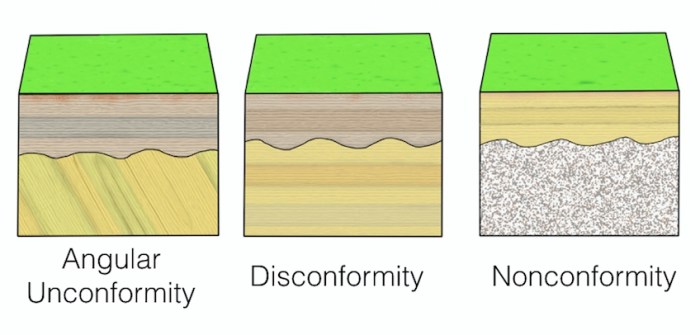Match the types of unconformities with their correct descriptions. – Unconformities are geological features that represent gaps in the rock record. They can be caused by a variety of processes, including erosion, deposition, and tectonic activity. In this article, we will discuss the different types of unconformities and provide examples of each type.
Unconformities are important because they can provide information about the geological history of an area. They can also be used to identify potential hydrocarbon reservoirs and other natural resources.
Types of Unconformities

Unconformities are geological features that represent gaps in the rock record. They occur when a sequence of rocks is interrupted by an erosional surface or a hiatus in deposition. There are several different types of unconformities, each with its own unique characteristics and mode of formation.
Descriptions of Unconformities: Match The Types Of Unconformities With Their Correct Descriptions.

The following are the main types of unconformities:
Angular Unconformity
An angular unconformity is a type of unconformity in which the younger rocks are tilted at an angle to the older rocks. This type of unconformity forms when the older rocks are folded or tilted and then eroded, and the younger rocks are then deposited on the eroded surface.
Disconformity
A disconformity is a type of unconformity in which the younger rocks are parallel to the older rocks, but there is a gap in the rock record. This type of unconformity forms when there is a break in deposition, but the older rocks are not tilted or folded.
Nonconformity, Match the types of unconformities with their correct descriptions.
A nonconformity is a type of unconformity in which the younger rocks are deposited on an eroded surface of older rocks that are not sedimentary. This type of unconformity forms when the older rocks are igneous or metamorphic and are then eroded, and the younger rocks are then deposited on the eroded surface.
Matching Types of Unconformities with Descriptions

The following table summarizes the different types of unconformities and their descriptions:
| Type of Unconformity | Description | Characteristics | Formation |
|---|---|---|---|
| Angular Unconformity | Younger rocks are tilted at an angle to the older rocks | Tilted or folded older rocks, eroded surface | Folding, tilting, and erosion |
| Disconformity | Younger rocks are parallel to the older rocks, but there is a gap in the rock record | Parallel younger and older rocks, eroded surface | Break in deposition |
| Nonconformity | Younger rocks are deposited on an eroded surface of older rocks that are not sedimentary | Igneous or metamorphic older rocks, eroded surface | Erosion of igneous or metamorphic rocks |
FAQ Explained
What is an unconformity?
An unconformity is a geological feature that represents a gap in the rock record.
What are the different types of unconformities?
There are three main types of unconformities: angular unconformities, disconformities, and nonconformities.
How can unconformities be used to interpret the geological history of an area?
Unconformities can be used to identify periods of erosion, deposition, and tectonic activity.